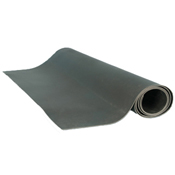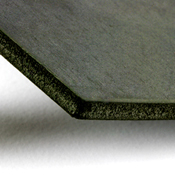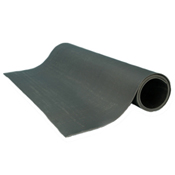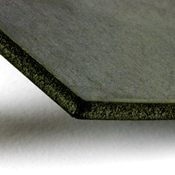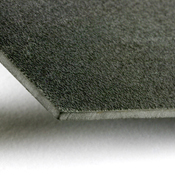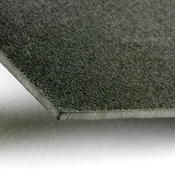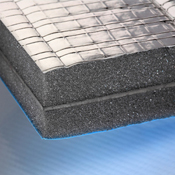MLV Soundproofing: The Ultimate Sound Reduction Product for Residential and Commercial Buildings
The Introduction of mass loaded vinyl as an effective sound control option was a blessing for architects and engineers. Mass Loaded Vinyl not only offers astounding sound reducing abilities, but is also safe to use and easy to apply. MLV is typically attached to joists or studs, followed by covering seams and joints with acoustic caulking or barrier tape. Once sound caulking is applied, seams are sealed with tape to ensure optimal soundproofing performance.
Vinyl MLV barriers block out every day noises, from traffic and street construction sounds to noises emitted by trains, buses and even aircraft. It’s a cost effective solution to a wide variety of sound issues. As a DIY soundproofing material, MLV is one of the best you’ll find at Soundproof Cow.
How Is Mass Loaded Vinyl Soundproofing Material Used?
You can sandwich Mass Loaded Vinyl soundproofing between drywall layers or other building materials to create noise reducing ceilings, floors and wall soundproofing for homes, commercial buildings and industrial facilities. Premier soundproofing systems combine absorption, damping, isolation and mass to achieve the best sound proofing results.
MLV sound barriers offer exceptional noise reduction by adding mass with minimal thickness. For example, Mass Loaded Vinyl #2 is only ¼ inch thick. MLV #1 is even thinner, at 1/8 inch thick. MLV #1 has a standalone sound transmission class (STC) rating of 26, and MLV#2 has a standalone STC rating of 32. Noises don’t stand a chance with that kind of density stopping unwanted sound waves from entering a room, music studio or office.
You can also wrap plastic plumbing pipes, steel columns, metal ducts and just about anything else with MLV to minimize noise transmission.
Compared to drywall, MLV is thinner, softer and remains flexible after installation. Mass loaded vinyl sound barriers are an effective addition to drywall and plywood building assemblies. The flexibility of the MLV product increases vibration control and dissipates more sound energy than traditional building materials. The Increased density provided by MLV also increases middle and high frequency sound control.
MLV Sound Barriers Are Reflective Barriers
As a “reflective barrier,” Mass Loaded Vinyl soundproofing does not have absorptive qualities. Instead, it contains or blocks sound waves. This keeps noise outside or inside a space. MLV acts as an effective sound barrier, regardless of which side of a wall you install it on. Mass Loaded Vinyl provides even greater soundproofing power when you combine it with other noise reduction components, such as furring channels, vibration isolation mounts and sound clips. In addition to soundproofing buildings, this multipurpose soundproof vinyl barrier can be used on AC compressor enclosures, generators, numerous industrial applications, high-end home entertainment systems and even in radio stations.
How to Choose the Right MLV Quiet Barrier® Soundproofing Item
If you’re new to the idea of installing soundproofing materials like MLV sheeting to reduce noisiness, you may wonder which type of sound barrier to choose. Consider these factors to determine which product makes sense for your upcoming commercial or residential sound reduction application project.
Thickness
Our MLV Quiet Barriers® come 1/8-inch and 1/4-inch thicknesses. While it may not seem like a lot, an 1/8 inch can be meaningful if you’re sandwiching your MLV sheet between floorboards or ceiling materials. The same holds true if you’re planning to wrap the barrier around an object.
Noise Level
Is your noise level subtle or substantial? If you’re trying to dampen ambient sounds like occasional echoes, you may find that a thinner MLV sheet makes sense. If you’re attempting to reduce sound in a naturally noisy place, like a highly active call center room or recording studio, you may need a thicker grade of MLV soundproofing. Contact us for a complimentary acoustic analysis.
Amount of Materials
Both Quiet Barrier® HD and Quiet Barrier® MD come in sheet and roll forms. This variety allows you to shop for the perfect fit for your needs. As the old saying goes, measure twice and cut once! Measure your space to help determine which MLV sound barrier Quiet Barrier® product to buy.
Easy Installation With Quiet Barrier® MLV Sound Deadening Solutions
Our MLV soundproofing product is easy to install. Whether you’re a seasoned contractor, a sound engineer or a DIYer, you can block sound waves with ease.
In most applications and installations, you’ll need basic toolbox items such as a cutting instrument, measure tools, hammer, roofing nails and caulk or another adhesive. When applying MLV sound barrier to walls and ceilings, simply measure, cut and nail in place. For floor applications, our team recommends cutting and laying the MLV sheeting in a brickwork pattern. You can then glue individual MLV sheets in place using high-performance PL Polyurethane Construction Adhesive.
Purchase MLV Sound Barriers Online Today
When you buy MLV sound barriers from Soundproof Cow, you’re guaranteed to receive one of the best, most effective noise reduction products available. You’ll also find comprehensive information about MLV constituents on our website, as well as easy-to-follow installation instructions if you’re an industrious DIY-er.
If you’re considering vinyl Mass Loaded Vinyl barriers but still don’t know if it’s the right product for your situation, give us a call at 1-866-949-9269 and we’ll be more than happy to answer your questions about this versatile and effective soundproofing product. Now is a better time than ever to start making the world a quieter, happier place — don’t you think?
Frequently Asked Questions About MLV Soundproofing
Still have some questions? Find your answers below:
Does MLV Really Work?
Yes, MLV is effective at blocking out noise. MLV’s physical properties make it capable of true soundproofing. It will contain sound to the room it was created in or keep it out of one that you want to keep quiet.
Sound goes between rooms in two ways — through the air or through a structure. Sound pokes through cracks or wiggles through walls. Walls are harder for sound to get through because they have a higher density than air. The denser a substance is, the more difficult it is for sound to move through. MLV fortifies a surface’s density while also covering any cracks, reducing sound transmission.
We even assign each MLV product a metric to show how effective it is — sound transmission class (STC). STC ratings describe how effective a surface or material is at preventing noise from traveling between rooms.
The higher a product’s STC rating, the more capable it is of blocking sound. Materials with an STC rating of up to 25 allow normal speech to be understood through a wall. By 50, loud sounds are hardly audible on the other side. Our MLV sheets have STC ratings ranging from 27-32 depending on thickness — excellent performance for a material as thin and lightweight as MLV.
How Much Does Mass Loaded Vinyl Reduce Sound?
The amount of sound MLV reduces depends on its thickness. Higher-density materials have a higher STC rating than thinner light weight alternatives.
Each of our MLV products has an STC rating that describes how much sound it can reduce.
The STC rating comes from a calculation that compares decibel levels inside the room with the decibel level outside of the room.
We calculate the mass loaded vinyl STC rating by measuring sound at different frequencies inside and outside of the room where it’s generated. We subtract the decibel level outside from the decibel level inside at each frequency, then add all of the differences together and divide by the number of frequency selections we recorded. This final product is the STC rating.
Does MLV Absorb or Reflect Sound?
MLV’s primary role is to block sound transmission by increasing the density of the surface where you install it.
Because limiting sound transmission is an MLV sheet’s job, it lacks the same absorptive properties as other products like acoustic foam. MLV absorbs little to no sound, instead reflecting it back into the room.
While sound reflection results in greater echoing and reverberation inside the room of origin, it helps prevent sound transmission. When noise reflects off a wall, less of its energy transmits through to the other side.
MLV still offers a small amount of absorption despite its reflective properties — especially compared to hard materials like concrete, drywall or brick. MLV has a soft exterior, so some sound will disperse across its surface. It can also reduce vibrations due to its softness. Installing it on a wall can dampen structural noise.
Is Mass Loaded Vinyl Good for Soundproofing?
Yes, it’s great for soundproofing. MLV’s high density relative to its size makes it an efficient soundproofing tool. Install MLV on the inside or outside of a wall to bolster its sound transmission defenses. The thicker a wall is, the more energy sound needs to pass through.
Beyond its noise-blocking capabilities, MLV is great for soundproofing because it’s easy to use. We design MLV to feature pressure-sensitive adhesive. Just peel the paper off of the back and stick the MLV sheet to the wall or ceiling.
MLV works just as well on the outside or inside of a wall. If you’re soundproofing an existing building, apply MLV to the outside of the walls for non-invasive soundproofing. Cover the MLV with artwork or a tapestry if you want to conceal it. If you’re constructing a new building or putting up new walls, install your MLV sheets on the inside as you work.
Can You Put MLV Between Drywall?
MLV can easily install between layers of drywall while you put up new walls. You can either stick the sheets in the open space to either side of the studs or place some directly between the studs and the walls.
MLV will always add mass to the surface you place it on, which helps prevent sound transmission. Decoupling a wall from its studs using MLV turns the wall into a limp mass barrier that absorbs more sound than a wall directly on its studs. The slight cushion softens the impact when a soundwave hits the wall, improving its soundproofing performance.
What are The Benefits of Quiet Barrier®?
At Soundproof Cow, we carry six different products in our Quiet Barrier® line, which offers you the following benefits:
- It takes less than ten tools to install
- Quiet Barrier® soundproofing products are available with a peel-and-stick sensitive adhesive (PSA).
- Pound for pound, Quiet Barrier® products have better noise reduction characteristics than steel and other building materials.
- Due to its sheet, roll, length, and width variety, the mass of Quiet Barrier® blocks sound while its flexible nature dampens sound energy, giving improved acoustic performance over competitive rigid products.
- It’s made in the US and of 15% recycled materials
With over 1.5 million square feet of Quiet Barrier® soundproofing products installed nationwide, these are just a few of the attributes and advantages you can expect.


